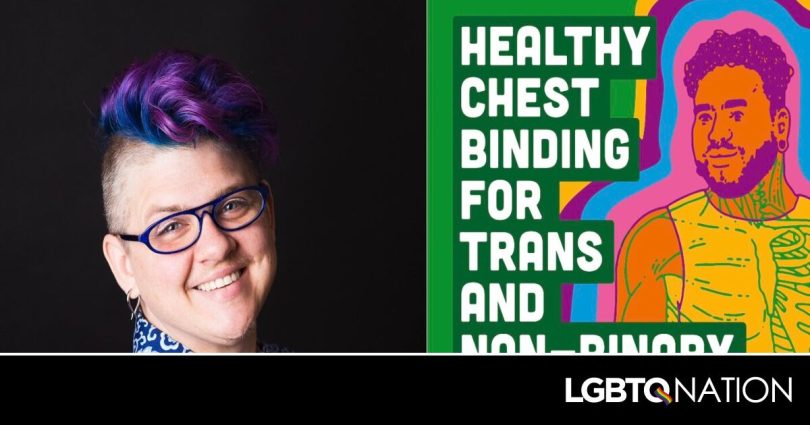The following is an excerpt from “Healthy Chest Binding for Trans and Non-Binary People: A Practical Guide” by Frances Reed, available April 18th, 2024.
In my early thirties, I suffered a binding injury that would end up defining my career. At that time in my life, I hadn’t figured out how to name my gender identity, but I knew that I was uncomfortable in my skin. Nature cursed me with a large chest, and no matter what I changed about my gender expression, the world saw breasts and made up its mind that I was a woman. The more I experimented with genderqueer expression, the more apparent it became that I was unseen by the world. And then a friend of a friend offered me one of their old binders.
It was stained from the previous owner’s sweat and frayed where it had been cut shorter, but when I put that ratty thing on for the first time, I felt positively euphoric. I was suddenly aware of the dysphoria that I couldn’t even name until I felt it abate. That was over a decade ago, and I have not forgotten that feeling.
Never Miss a Beat
Subscribe to our newsletter to stay ahead of the latest LGBTQ+ political news and insights.
Elements of my gender were being successfully expressed in the world and I could finally explore who I wanted to be. I was no longer leading with my breasts. They were no longer defining me before I had a chance to. People still read me as a woman, but I felt a shift in their perceptions. I sensed strangers noticing my gender expansiveness, and I was nothing short of high on the affirmation.
I was a massage therapist doing physically demanding work with my upper body for long hours. My career was just getting off the ground and I was pushing my body too hard. A day at work was like doing eight hours of resistance-band training on arms, back, and pecs. I believed binding was having no impact. I didn’t consider that my muscles were working much harder against the power-mesh fabric of my binder.
I had no way of knowing it, but my second-hand binders were almost certainly too small for me. They didn’t have tags, so I didn’t know the brand or size. Even if I’d known the brand name, their website didn’t mention any advice, especially for assigned female at birth (AFAB) bodies, about when and where to bind. Why? Because their products were designed for and marketed to cis men for gynecomastia (derogatorily called “man boobs”). But, even in the queer and trans community, I didn’t hear anyone talking about binding health. It genuinely never occurred to me that wearing my binder when doing strenuous physical work was a bad idea.
I wanted to wear this life-changing, but overly constrictive, binder all the time. It replaced my bra. I didn’t know it was harming me. If I’d had a resource spelling out the risks and best practices, it could have changed everything that came next in my life.
I’d been working in my binder at a stressful pace for about six months and suddenly a pain wrenched the right side of my chest. Certain movements sent a lightning bolt of pain so intense I would cry out uncontrollably and gasp for breath. Turning my head, lifting my shoulder, and projecting my voice all triggered the pain. Laughing and crying hurt. It was exhausting to be in constant pain. I stopped doing activities I loved.
It wasn’t long until my right shoulder joined in on the pain. With reaching or pushing, the inflamed tissue burned inside the joint. Every night I built an elaborate pillow fort to prop up my arm, and the smallest shifts woke me up in sudden pain. My wife had to help me get dressed because I couldn’t lift my arm over my head. Ibuprofen didn’t touch it; muscle relaxers didn’t change it; and cannabis couldn’t dull it. The pain was ever-present—as was my binder.
It seems outrageous to say now, but, at the time, I didn’t connect my pain to binding. I assumed that I’d hurt myself working, but I couldn’t lose my income so I kept pushing through it. I dissociated and used the muscles and joints of my upper body in strenuous repetitive ways on a daily basis. I made a fool’s gamble and lost. Eventually, I ended up unable to work for five months.
On my way to meet friends one day (wearing my binder, of course), the center of my chest started to ache intensely, and it was frighteningly hard to breathe. I thought I might be having a heart attack and ripped off my shirt and binder at a stop light. Within a few minutes of removing the binder, the ache became more manageable, and it finally hit me: binding was the root of all of my upper body pain.
Though binding was an integral part of how I coped with my dysphoria, I had to prioritize my physical health; I’d let it go on too long. I was too injured to bind for short periods—even when it mattered most. Whenever I put on my binder, the crushing ache in my chest became intolerable almost immediately. As if losing the ability to bind wasn’t bad enough, I couldn’t wear a sports bra or even a regular bra without pain. The only way that I could function was with my DDD chest hanging free. These appendages were bigger and more obvious as womanly breasts than ever before, and I was plagued by seeing my reflection.
After binding but before the injury, my self-confidence was at an all-time high. Now, not only was the glorious affirmation gone, but it was replaced by excruciating pain and poor self-image. The trifecta of symptoms—chest ache, shoulder inflammation, and a stabbing pain—persisted and eventually I was desperately doing anything to make it all go away.
I spent a few thousand dollars trying everything: doctor, acupuncturist, chiropractor, energy healer, massage therapist, and physical therapist. I endured transphobic appointments twice in hopes of getting relief. Each practitioner had a theory, but none knew anything about binding or how it impacted the body. Ultimately, combining the wisdom of a chiropractor, a fellow massage therapist, and my own insight, we teased apart the three injuries. The stabbing pain came from the partial dislocation of my third rib that was affecting how I moved my shoulder. I’d activated an old rotator cuff injury and had tendonitis and impingement in my shoulder, which explained the joint pain. And by not listening to my body’s pleas for rest, I developed inflammation in the ribs called costochondritis.
Once the rib got adjusted, I was slowly able to heal the three injuries and regain the strength I had lost. When I could finally tolerate wearing an undergarment again, it had to be a positively horrendous bra that I hated. It took almost a year but the costochondritis healed enough for me to switch to a sports bra. I accepted that I would never be able to bind again.
In 2015, I heard about a new, safer binder called gc2b. I purchased one immediately. The euphoria returned the minute I put it on. I’d been frozen in place on my gender journey. Now I finally resumed becoming my truth in the world. Although I was tempted, I never wore a binder while giving a massage again.
***
My self-esteem, my physical health, my finances, my social life, and my gender identity were all impacted by a binding injury. I almost had to choose between doing what I loved and being fully who I am. No one should be in that position or in that much pain, so I’ve used my training as a massage therapist to study how binders impact the body and specialize in the treatment of people experiencing binding pain. This book is a combination of a decade of observation, dozens of informal case studies, years of continuing education, and personal experience of binding.
Since 2012, I’ve treated transmasculine clients who were binding and studied their cases. As word got out that I treated binding pain, more clients showed up on my table in need of help. I’ve consulted with colleagues on exercises to treat hyper-stretched and hyper-contracted muscles. I studied trigger point release to help alleviate referred pain and structural integration to free the rib cage and shoulder blades from collapsed posture.
To spread this information, I started teaching workshops at conferences and college campuses. I went on podcasts and launched a website, www.healthybinding.com, to centralize information. I took each of these steps guided by the goal of creating tools for the transmasculine community to benefit from these techniques.
Cautionary tales are important because they remind us to be responsible. But trouble lies in purely focusing on the injury. My story proves that there are some risks involved, yes. But throughout this book, I will teach you what not to do, how to find a binder option that suits your needs, and how to get the most out of self-care, and then binding is a perfectly healthy choice.
©2024 Jessica Kingsley Publishers. Reprinted with permission. This article may not be reproduced for any other use without permission.







